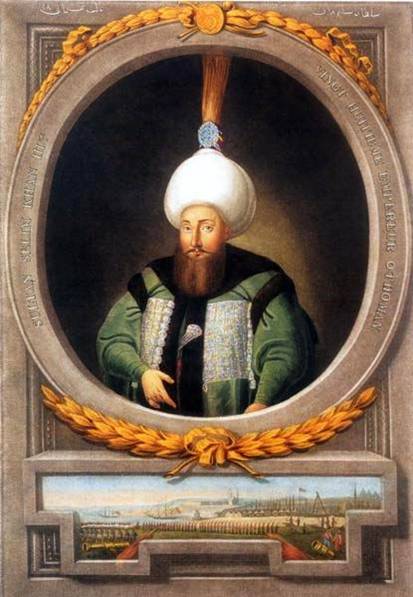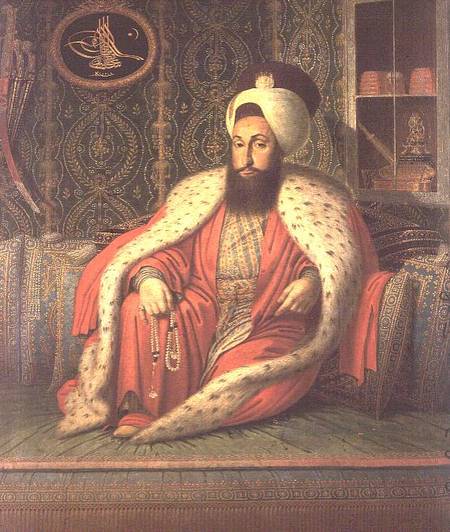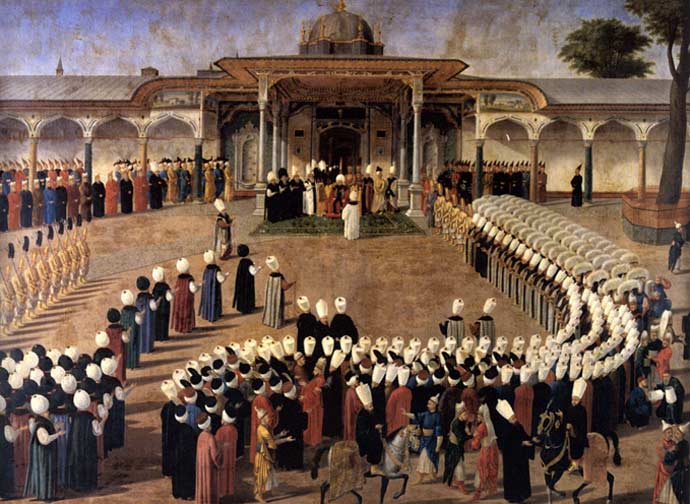<Back to Index>
- Physicist James Prescott Joule, 1818
- Poet Adam Bernard Mickiewicz, 1798
- Sultan of the Ottoman Empire Selim III, 1761
PAGE SPONSOR


Selim III (Ottoman Turkish: سليم ثالث Selīm-i sālis) (December 24, 1761 – July 28/29, 1808) was the Sultan of the Ottoman Empire from 1789 to 1807. He was a son of Mustafa III (1757 – 74) and succeeded his uncle Abdülhamid I (1774 – 89). He was born in Constantinople. His mother was Valide Sultan Mihr-i shah. His attempts to reform the Ottoman Empire ended with his assassination.
The talents and energy with which Selim III was endowed had endeared him to the people, and great hopes were founded on his accession. He had associated much with foreigners, and was thoroughly persuaded of the necessity of reforming his state. But Austria and Russia gave him no time for anything but defense, and it was not until the peace of Iaşi (1792) that a breathing space was allowed him in Europe, while Napoleon's invasion of Egypt and Syria soon called for Turkey's strongest efforts and for the time shattered the old standing Franco - Ottoman alliance.
Selim III profited by the respite to abolish the military tenure of fiefs; he introduced salutary reforms into the administration, especially in the fiscal department, sought by well-considered plans to extend the spread of education, and engaged foreign officers as instructors, by whom a small corps of new troops called nizam-i-jedid were collected and drilled. So well were these troops organized that they were able to hold their own against rebellious Janissaries in the European provinces, where disaffected governors made no scruple of attempting to make use of them against the reforming sultan. Emboldened by this success, Selim III issued an order that in future picked men should be taken annually from the Janissaries to serve in their ranks.
The
Janissaries and others who opposed reforms rebelled at Edirne, and due
to their number, exceeding 10,000, and the violence of their
opposition, it was decided that the reforms must be given up for now. Serbia, Egypt and the principalities were successively the scene of hostilities in which Turkey gained no successes, and in 1807 a British fleet appeared at Constantinople, strangely, to insist on Turkey's yielding to Russia's demands and on the Ottomans dismissing the ambassador of Napoleon, Horace Sebastiani (Dardanelles Operation). Selim
III was, however, thoroughly under the influence of Sebastiani, and the
fleet was compelled to retire without effecting its purpose. But the
anarchy, manifest or latent, existing throughout the provinces proved
too great for Selim III to cope with. The Janissaries rose once more in
revolt, induced the Sheikh-ul-Islam to grant a fetva against the reforms, dethroned and imprisoned Selim III, and placed his cousin Mustafa on the throne, as Mustafa IV (1807 – 08).
The pasha of Rustchuk, Mustafa Bayrakdar,
a strong partisan of the reforms, collected an army of 40,000 men and
marched on Constantinople with the purpose of reinstating Selim III,
but he came too late. The ill-fated reforming Sultan had been stabbed
in the seraglio by the Chief Black Eunuch and his men, and Bairakdar's only resource was to wreak his vengeance on Mustafa IV and to place on the throne Mahmud II (1808 – 39), the sole surviving member of the house of Osman. Another
version of his murder states that after his deposition, Selim was
staying at the Harem. The night of Thursday, July 28, 1808, he was with
his favourite lady, Refet Kadın, and a slave girl or perhaps another
favourite Pakize Kadın in attendance. Alemdar Mustafa Pasha, a loyalist of Selim, was approaching the city with his army to
reinstate Selim. Therefore Mustafa IV gave orders to murder him and his
brother Prince Mahmud. The assassins were apparently a group of men,
including the Master of the Wardrobe called Fettah the Georgian, the
Treasury steward Ebe Selim, and black eunuch named Nezir Ağa. Selim
apparently knew his end was coming when he saw their swords drawn.
Pakize Kadın threw herself between them and her lord, she was cut in
her hand. Refet Kadın started screaming in terror, another slave girl
who rushed in fainted when she saw what was about to happen. A struggle
ensued and the former sultan was cut down and murdered, his last words
apparently being "Allahu Akbar" ("God is great"). Refet Kadın
threw herself on the body but was dragged away. The body was quickly
wrapped in a quilt. The assassins moved on to find Prince Mahmud and
attempt to murder him too, he was more fortunate though and later
ordered the assassins to be executed. Selim III would be the only
Ottoman sultan to be killed by the sword. He died in Constantinople. A great lover of music, Sultan Selim III was a composer and performer of significant talent. He created fourteen makams,
melodic types, three of which are in current use today. Sixty-four
compositions belonging to Selim III are known, some of which are part
of the regular repertory of Turkish classical music performers. Aside from composing music, Selim III also performed on the ney and tanbur. Selim III's interest in music started in his days as a prince (shahzade) when he studied under Kırımlı Ahmet Kamil Efendi and Tanburi İzak Efendi.
He was especially respectful of Tanburi İzak Efendi, and it is
recounted that the Sultan stood up when Tanburi İzak Efendi entered the
court. As a patron of the arts, Selim III encouraged musicians of his day including Dede Efendi and Baba Hamparsum.
The Hamparsum notation system that he commissioned became the dominant
notation for Turkish and Armenian music. His name is associated with a
school in Turkish classical music due to the revival and re-birth of
music at his court. Selim III was also interested in western music and in 1797 invited an opera troupe for the first opera performance in the Ottoman Empire. Writing under the nom de plume İlhami, Selim III collected his poetry in a divan. Among regular attendees of his court were Şeyh Galip, one of the greatest Ottoman poets. Furthermore, Selim III was a member of the Mawlawi Order of Sufi Whirling Dervishes, and entered into the order at the Galata Mevlevihanesi under the name 'Selim Dede'. Sultan Selim III was a renowned composer inventing many musical compositions including a legendary ayin, a long and complicated liturgical form performed during the religious ceremonies of the Mevlana (Jalal ad-Din Muhammad Balkhi-Rumi) Tariqah of Sufi Whirling Mystics, which is known as the suzidilara makam. He extended his patronage to Antoine Ignace Melling,
whom he appointed as the court architect in 1795. Melling constructed a
number of palaces and other buildings for the Sultan and created
engravings of contemporary Constantinople.
